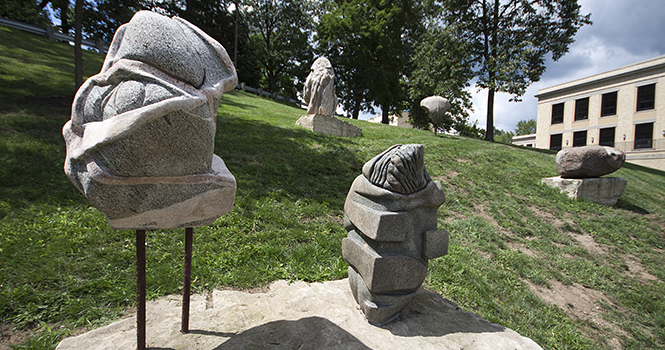KSU home to many artistic sculptures
August 22, 2012
If you’re a new student getting acclimated to your unfamiliar surroundings, you’ll likely spend the first few days finding your way across campus through points of reference. But there’s no need to fret over memorizing the countless names of academic buildings you may never even enter or to study a campus map until you’ve given yourself a migraine.
Kent State is home to several memorable landmarks with rich artistic and historic significance you can use to keep tabs on your location.
The statues found along the Esplanade across campus are part of the Sculpture Walk — an initiative between the university and the Ohio Art Council that was launched in 2010, according to Kent State’s website.
Some of the older pieces were pre-existing fixtures or items that were commissioned to commemorate the events of May 4. But according to the Ohio Arts Council, others are part of an ongoing project funded by the Ohio Percent for Arts Act, which requires one percent of funding used to renovate a building be spent on installing art when state funding exceeds $4 million.
The policy took effect on July 1, 1990, and in accordance, Kent State has commissioned a variety of projects all across campus. Here’s a look at some of the most interesting pieces that might puzzle you at first glance.
Athleta
Giancarlo Calicchia, an Italian sculptor from Cleveland, created “Athleta” as a part of a series called “The Witnesses.”
Calicchia said he named them “The Witnesses” because the stones, as parts of the earth, witnessed the evolution of this part in the world. He said he now wants them to witness our existence and what our generation is doing.
The pieces are meant to represent the parts of the human spirit that never stop growing, such as the heart and mind.
Athleta was part of the Ohio Percent for Art Program.
Eye to eye
Installed in 2010, the two giant, aluminum heads with eyes locked on one another make their home on the hill behind Kent Hall.
Their sculptor, Barry Gunderson, is a professor of art at Kenyon College. He said he found his inspiration for this piece in the work of psychologists. The arrangement of the heads is supposed to raise the questions, “Who is the analyst, and who is the subject?”
“Every public art piece I do, I try to find some relation to the site so it’s not just being plopped into place,” Gunderson said.
Keeping this in mind, the location behind Kent Hall, home to Kent State’s Department of Psychology, made sense.
Fallen Students’ Memorial
Continuing on the legacy of May 4, the parking lot near Prentice Hall has been marked as the site of death of the four slain students. A granite marker — dedicated May 3, 1975 — can be found at the base of a tree in the lot where it is inscribed with the names of Allison Krause, Jeffrey Miller, Sandra Scheuer and William Schroeder.
Perhaps the most visually puzzling element to those unfamiliar with Kent State’s history is the black bollards topped with torchlights around some of the spots in the parking lot. These mark the actual locations of the four dead following May 4.
Each of these memorials contain a granite cornerstone engraved with each student’s name and the date.
This piece was commissioned as part of the Ohio Percent for Art Program.
The Kent Four
Alastair Granville-Jackson, a former faculty member for the School of Art, created this sculpture in 1971. It was the first art memorial in memory of the four students killed on May 4, 1970.
The orange, metal object with four hollow arms is intended to project live flames.
Professor Granville Jackson said, “After considering the manner of death — four rifle barrels — I took these symbols of destruction and turned them into a new emblem to ponder.”
The Limits of Spoken Language: Congeries
Jarrett Hawkins designed this piece, located directly in front of the library.
Made of 12-foot sheets of Corten steel, the same material used for the Solar Totem, the sculpture is meant to represent the limitations of spoken language.
“For me, citing a piece at the University Library verges on poetic,” Hawkins said when the piece was revealed. “If the university is a place of ideas, the library is the gathering point of ideas past and present to be accessed at means.”
Behind the Brain
This piece is actually an interactive sculpture that grew into an entire plaza located behind Merrill. A former School of Art sculpture professor, Brinsley Tyrrell, designed it. Known to most students as “The Brain,” the plaza’s most prominent feature is the 13-foot-tall sculpted brain facing Terrace Drive.
The spinal nerve of the brain leads into the ground and back to the plaza with a smaller brain, a fountain and sculpted benches that resemble bookshelves.
“My first idea for it was that we needed to build a wall bank to shut out all the traffic,” Tyrrell said, “Eventually that band became the library of books, and from the books evolved the brain, called the ‘Seed of Inspiration.’”
This piece was commissioned as part of the Ohio Percent for Arts project.
Solar Totem
Created by Don Drumm, a fine arts graduate and well-known Akron-based sculptor, this Corten steel abstract sits in front of Taylor Hall.
A bullet fired by the Ohio National Guard on May 4, 1970 penetrated the metal structure, leaving a hole. The piece is now part of the National Register of Historic Landmarks, and it often views by visitors to the May 4 memorial.
Contact Justin Lagore at [email protected].

























